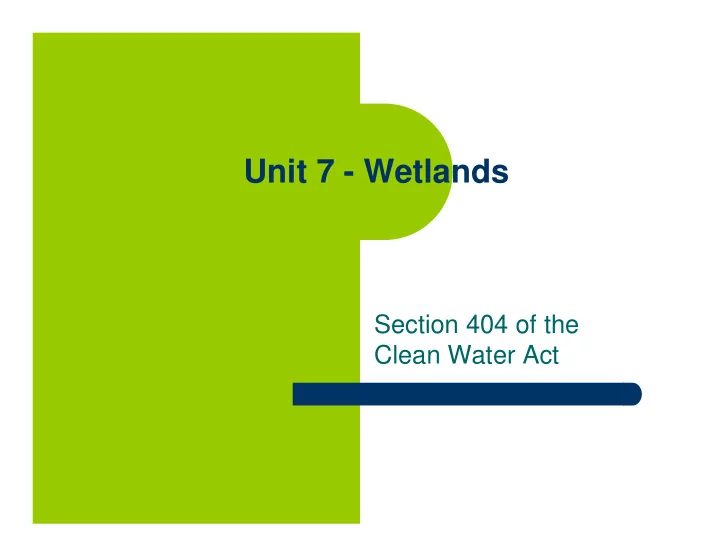

Unit 7 - Wetlands Section 404 of the Clean Water Act
Value of Wetlands � Maintaining and enhancing water quality; � Preventing and minimizing damage from floods and storms; � Protecting shorelines against erosion; � Providing habitat to a variety of species of fish and wildlife (many of which are endangered or threatened); and � Enhancing aesthetic and recreational experiences.
Clean Water Act § 404 Program � Centerpiece of federal wetlands regulatory programs administered by the Corps � “The Secretary [of the Army] may issue permits, after notice and opportunity for public hearings for the discharge of dredged or fill material into the navigable waters at specified sites.”
Federal Agency Roles � Army Corps of Engineers – Responsible for issuing permits for the discharge of dredged and fill material. � Environmental Protection Agency – CWA requires the Corps to apply guidelines promulgated by EPA in conjunction with the Corps. – EPA may also “veto” any Corps decision to issue a § 404 permit.
Covered Activities � CWA § 301 contains a general prohibition against the “discharge of any pollutant by any person.” � Pollutant includes a variety of fill material, such as rock and sand, and “dredged spoils.”
Jurisdictional Scope � For § 404 to apply, two questions must be answered in the affirmative: – Can the area be delineated as wetland? – Are these wetlands “navigable waters” (otherwise know as waters of the U.S.)?
Regulatory Definition of Wetland “ Those areas that are inundated or saturated by surface or ground water at a frequency and duration sufficient to support, and that under normal circumstances do support, a prevalence of vegetation typically adapted for life in saturated soils.”
“Waters of U.S.” Once a site is properly characterized as a wetland, the Corps’ regulations regard it as within the “waters of the U.S.” in three circumstances: � Wetland is an interstate wetland; � Wetland is adjacent to other waters of the U.S, or � The use, degradation or destruction of the wetland could affect interstate commerce.
Adjacent Wetlands � Corps has construed § 404 to encompass wetlands adjacent to waters of the U.S. – “Adjacent” means “bordering, contiguous, or neighboring.” � Supreme Court upheld the Corps regulation of “adjacent wetlands” in U.S. v. Riverside Bayview Homes in 1985.
Isolated Wetlands � Corps regulations provide for jurisdiction over “other waters” of the U.S., including wetlands the “use, degradation, or destruction of which could affect interstate or foreign commerce.” � Intrastate waters without a hydrological or other ecological connection.
Migratory Bird Rule � Corps had attempted to regulate isolated wetlands through Migratory Bird Rule which extended §404 jurisdiction to waters that – Are used as habitat by birds protected by Migratory Bird treaties; – Are used as habitat by migratory birds that cross state lines; or – Used by endangered species
Prairie Potholes - South Dakota
SWANCC � In 2001, Supreme Court in Solid Waste Agency of Northern Cook County v. Corps struck down the “Migratory Bird Rule.” – Seemed to narrow ruling in Riverside Bayview Homes. � Need a “significant nexus” between wetlands and “navigable waters.”
U.S. v. Rapanos
Pine River Site This is an aerial photo, taken in 1982, before any development took place at the 200-acre Pine River Site. Site clearly borders the Pine River, a 50-foot wide body of water.
Rapanos’ Property Undisturbed spot, with characteristic wetlands vegetation.
Drainage Ditch One of the large drains dug on the property to drain the wetlands and prepare the site for development. Some were 7-foot deep and 15-foot wide.
Transformation of Property
Pine River Site in 1998 The pattern of roads suggests intended use was a housing development. 15 of the 49 acres of wetlands were destroyed.
Plurality Opinion � Scalia, Roberts, Thomas, and Alito � Two-part test for establishing jurisdiction: – Adjacent channel contains a relatively permanent body of water connected to traditional interstate navigable waters; and – Wetland has a continuous surface connection with that water making it difficult to determine where the “water” ends and the “wetland” begins.
Justice Kennedy’s Opinion � “Significant Nexus” required � Present “if the wetlands, either alone or in combination with similarly situated lands in the region, significantly affect the chemical, physical, and biological integrity of other covered waters more readily understood as navigable.”
What test do you apply? � So far most courts have applied Kennedy’s “significant nexus” test. � Why? – Any wetlands that meet Kennedy’s test would be considered jurisdictional by the 4 dissenting judges. – Have a majority of the court. � Problem? Not all wetlands meeting plurality’s test would meet Kennedy’s test.
Implications? � Important to note that the Rapanos decision is not limited to wetlands issues. � Definition of “waters of the U.S.” is central to all jurisdictional questions under the CWA. – If small creeks and ditches are not covered by the Act, factories and other traditional point source dischargers arguably could discharge to them without an NPDES permit. – Ripple Effect - RCRA
Recommend
More recommend